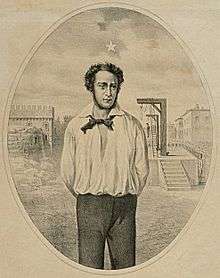
Stella d'Italia (Star of Italy) also known as Stellone d'Italia (Great Star of Italy).
The Stella d’Italia or Stellone d'Italia (Italian: "Star of Italy" or "Great Star of Italy") is the most ancient identity symbol of the Italian land. In modern times it has been associated with the Italia turrita (Towered Italy), the ancient allegorical representation of Italy.
Origins
The mythology of the Stella d’Italia goes back to the 6th century BC, when the Siceliot poet Stesichorus, in his poem Iliupersis (The Fall of Troy) creates the legend of Aeneas: escaping from Troy, seized and fired by the Greeks, he goes back to Italy, the land of his ancestors. The tale of Aeneas’ travels by the sea, guided by the maternal Stella Veneris toward the Italian coasts, was later re-used by Varro and Vergil, who give birth to the political tradition of Caesaris Astrum (the star of Caesar) and to the geographical tradition of Italy as Esperia, from the ancient name Greeks gave to it. Both traditions are related to the evening star that identifies Italy as "the land of sunset" but also to the star of Venus, the goddess of love as universal force, which identifies Italy as land of Eros too, sung as such by poets.
The Star and the National personification
In 1603, in the second edition of his treatise Iconologia, Cesare Ripa associated the symbol with the Italia turrita, and creates a modern version of Italy’s allegorical personification: woman with a star on top of a towered crown, therefore supplied with the Corona muralis and the Stella Veneris. Ripa’s treatise inspired many artists like Canova, Bisson, Maccari, Balla, Sironi, until the 1920s. The allegorical image of the towered and star-topped Italy became popular during the Risorgimento, spreading through a large iconography of statues, friezes and decorative objects, tourist-guide covers, postcards, prints and magazines’ illustrations. In the Risorgimento period, evoking Aeneas’ journey toward the Italian coasts, patriot Giuseppe Mazzini mentioned again the national star’s myth that afterwards was recovered by Cavour and the new Savoyard kings of Italy. The reigning house even tried to get possession of it, suggesting that it was the Stella Sabauda (Savoys’ star), a family heraldic pattern about is not mentioned in any historical document preceding the unification of Italy.
In 1947, the Stella d’Italia was included in the centre of the Italian Republic official emblem, drawn by the designer Paolo Paschetto.
Gallery
| The Stellone of Italy in a postcard of the First World War, 1915-1918. |
| L’Italia turrita e stellata, 1861, Palazzo Reale of Naples. Note the little star on the crown. |
| Lithograph of the Italian patriot Ciro Menotti with the Star of Italy above his head (1875). |
|
See also
Bibliography
- Lista, Giovanni (2011). La Stella d’Italia. Milan: Edizioni Mudima. ISBN 978-88-96817-06-3.






.jpg)
.svg.png)